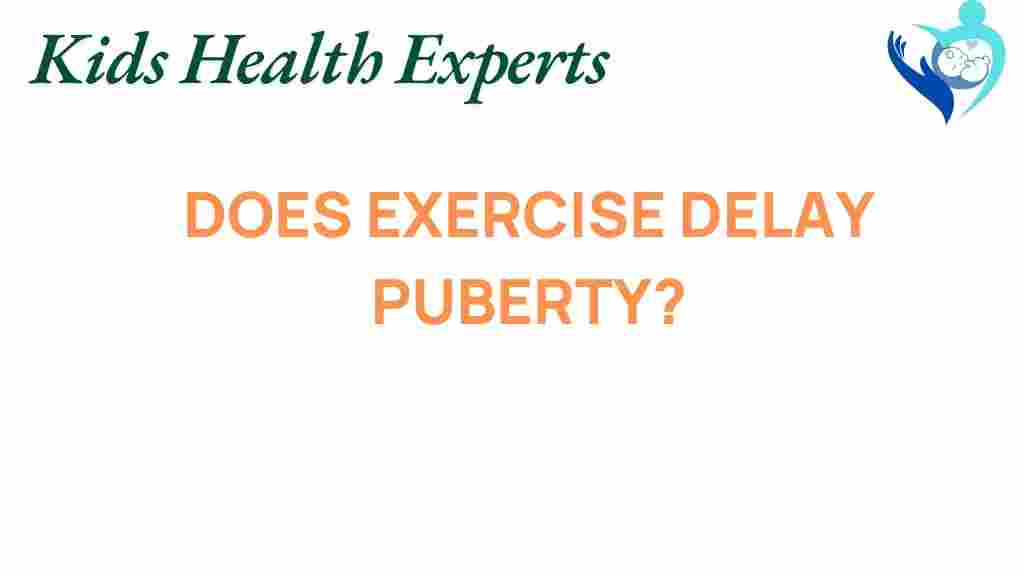The Surprising Impact of Exercise on Puberty Timing
Puberty is a critical period in adolescent health, marked by significant physical, emotional, and hormonal changes. The timing of puberty can vary greatly among individuals, influenced by various factors including genetics, nutrition, and lifestyle choices. One often-overlooked element is the role of exercise and physical activity in influencing growth and development during this pivotal stage. In this article, we will explore how exercise impacts the timing of puberty, its effects on hormones, and the overall well-being of youth.
Understanding Puberty and Its Importance
Puberty is the phase of life when a child’s body matures into an adult body, capable of sexual reproduction. This transformation includes the development of secondary sexual characteristics, such as breast development in girls and increased muscle mass in boys. The timing of puberty can significantly influence adolescent health, self-esteem, and social interactions.
Factors influencing the timing of puberty include:
- Genetics: Family history plays a crucial role in determining when an individual will enter puberty.
- Nutrition: A balanced diet rich in essential nutrients can encourage timely growth and development.
- Physical activity: Regular exercise can influence hormonal levels and body composition.
- Environmental factors: Stress, exposure to endocrine disruptors, and overall health can also affect puberty timing.
The Role of Exercise in Growth and Development
Exercise is essential for maintaining physical fitness and overall health during adolescence. It not only promotes healthy body weight but also influences hormonal balance, which can impact the timing of puberty. Here’s how:
- Hormonal Regulation: Physical activity stimulates the release of growth hormones and sex hormones, which are critical during puberty.
- Body Composition: Regular exercise helps maintain a healthy body fat percentage, which is crucial as body fat levels can influence the onset of puberty.
- Mental Health Benefits: Exercise reduces stress and anxiety, which can positively affect hormonal balances and overall adolescent health.
How Exercise Affects Hormones
The relationship between exercise and hormones is complex but vital to understanding how physical activity influences puberty timing. Here are some key hormones affected by exercise:
- Growth Hormone: Exercise stimulates the pituitary gland to release growth hormone, promoting physical growth and development.
- Estrogen and Testosterone: Physical activity can influence the levels of these sex hormones, which play a significant role in the development of secondary sexual characteristics.
- Cortisol: Exercise can help regulate cortisol levels, the stress hormone, thereby promoting a healthier hormonal environment for growth.
Recommended Physical Activities for Youth
Incorporating a variety of physical activities into a young person’s routine can be beneficial for their growth and development. Here are some recommended exercises:
- Aerobic Activities: Running, swimming, and cycling improve cardiovascular fitness and boost overall health.
- Strength Training: Bodyweight exercises or light weights can enhance muscle development and support bone health.
- Sports: Team sports like basketball, soccer, and volleyball promote not only fitness but also social skills.
- Flexibility Exercises: Activities like yoga or stretching can improve flexibility and reduce the risk of injury.
Step-by-Step Guide to Incorporating Exercise into Daily Life
Encouraging regular exercise in adolescents can be achieved by following these steps:
- Set Realistic Goals: Help them set achievable fitness goals, whether it’s running a certain distance or improving flexibility.
- Choose Enjoyable Activities: Encourage participation in sports or activities they enjoy to foster a positive attitude towards fitness.
- Create a Schedule: Establish a regular exercise routine that fits into their daily life, balancing school, sports, and relaxation.
- Monitor Progress: Keep track of their achievements to motivate and encourage them to continue.
- Encourage Team Participation: Joining sports teams or exercise classes can provide social motivation and support.
Troubleshooting Common Exercise Barriers
While exercise is beneficial, various barriers can prevent adolescents from engaging in physical activity. Here are some common issues and solutions:
- Lack of Time: Encourage short, high-intensity workouts that can be done in less than 30 minutes.
- Low Motivation: Pair exercise with social activities to make it more enjoyable and less of a chore.
- Access to Facilities: Promote outdoor activities that require minimal equipment, like running or hiking.
- Injury Concerns: Educate on proper techniques and warm-up routines to prevent injuries.
Conclusion
In summary, the impact of exercise on puberty timing is profound and multifaceted. Regular physical activity is crucial for hormonal regulation, growth, and development during this significant life stage. By promoting a culture of fitness and encouraging youth to engage in regular exercise, we can positively influence their health outcomes and support their journey through adolescence.
To learn more about the importance of physical activity in adolescent health, visit CDC Physical Activity. For tips on integrating exercise into daily routines, check out this helpful guide.
Encouraging a healthy lifestyle now will lead to a healthier, happier adulthood. Let’s empower our youth to embrace fitness for their well-being and a successful transition through puberty.
This article is in the category Growth and created by KidsHealthExperts Team
